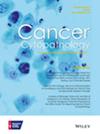Major mutations (e.g., KRAS, GNAS, TP53, SMAD4) in pancreatic cyst fluid (PCF) are useful for classifying and risk stratifying certain cyst types, particularly in cases with nondiagnostic cytology. However, the significance of uncommon minor mutations in PCF has yet to be reported.
In total, 127 PCF specimens (2014–2021) from 121 patients that underwent molecular analysis were identified, and detailed clinicopathologic data were recorded. Molecular testing was performed using a laboratory-developed next-generation sequencing panel.
Forty-five variants other than KRAS, GNAS, RNF43, TP53, CDKN2A, and SMAD4 were detected. Variants that were detected in five or more cases included ARID1A (n = 28), VHL (n = 17), BRAF (n = 12), ATM (n = 8), APC (n = 8), MEN1 (n = 5), serine threonine kinase 11 (STK11; n = 5), PIK3CA (n = 5), and CDH1 (n = 5). Thirty-eight of 121 patients (31%) had histologic confirmation on follow-up resection. Twenty-seven of 28 cysts (96%) with ARID1A mutations had concurrent KRAS/GNAS mutations; 17 (61%) were diagnosed as neoplastic mucinous cysts on cytology, and 10 (36%) were diagnosed as intraductal papillary mucinous neoplasm (IPMN) on histology (80% low grade). No patients developed disease recurrence or died of disease. Cysts with STK11 mutations had RAS co-mutations (KRAS, n = 5; NRAS, n = 1), and four of those five cysts (80%) were mucinous neoplasms with high-grade atypia on cytology. All three resection specimens were IPMNs with high-grade dysplasia or invasive carcinoma, and two of those patients died of disease.
In PCFs, ARID1A mutations were consistently associated with IPMNs (predominantly low grade) with no recurrences or deaths from disease. STK11 mutations appeared to be associated with high-risk mucinous cysts. The detection of minor variants may provide useful preoperative information and add value beyond single-gene genotyping of major mutations.


